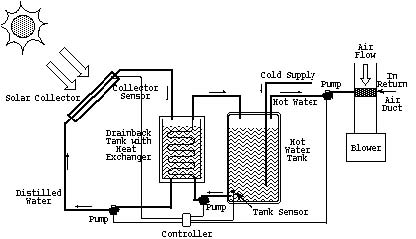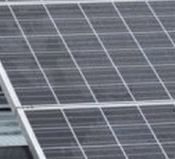OTHER WAYS TO USE SOLAR POWER AT HOME
Solar Pool Heating
Nothing could be simpler than solar pool heating. In fact, a lot of people do it without even realizing. Most floating pool covers are actually solar blankets. All you need to do is leave them lying on top of your pool whenever you get out and they’ll warm the water all summer long. Most solar pool covers cost less than $100 and take less than 2 minutes to pull off the pool and to putback into place when you’re done swimming.
If you live in a colder climate and already have a pool heater in place, connecting the pool heater to a small standard solar array (the same kind you use for powering your house) is one of the best possible introductory solar projects.
You’ll learn everything you need to know about building a solar array for your home without any risk of messing up your home electrical system.
By the time you’ve connected your solar cells to your pool’s heater, you’ll be ready to build a full sized solar array to power your house.
Solar Water Heating
Solar water heating is cheap, easy to do, and has been used for decades. You can easily generate most of your own hot water needs for all but the coldest parts of the year without using any electricity or gas.
A passive solar water heating system requires a little basic plumbing redesign. For starters, you hot water tank now goes on your roof instead of inside. This allows the hot water tank itself to be warmed by heat from the sun. The most basic system consists of a black painted metal tank enclosed in a wooden box with all exterior pipes also being painted black. This allows everything to absorb as much heat as possible. People started using simple black painted, roof mounted hot water tanks as early as 1896. The oil crisis of the 1970’s sparked a new interest in energy independence. That led to a whole new wave of solar hot water technology.
For warmer, more reliable hot water, you can connect a solar panel to your solar mounted hot water tank. Instead of gas or electricity powering the coil inside your hot water tank, you connect the inverter coming off your solar panel into your hot water heater and allow it to power the heater directly. These passive systems require very little maintenance, but in most climates they rarely get hot water up to the scorching temperatures people prefer for washing dishes and heavy duty laundry.
For those, you’ll need an active system, which includes monitors, controllers, reservoir tanks and sensors. An active solar hot water system is more reliable than a passive system, but is also hugely more complicated and prone to breaking down. Home DIY enthusiasts love them because they need endless tinkering. In general, they’re not recommended for people who want a low maintenance, worry free way of getting off the grid.
Solar Space Heating
If you’re not ready to go off the grid but you do have a perpetually cold room in your house, solar space heating is a low tech way to generate inexpensive heat.
Basically, you’re going to build a box that traps heat, put a fan at one end of the box, and then connect it to your home with the same sort of return duct you use to vent heat from your dryer.
Solar space heaters aren’t pretty, but they are cheap. You can build one for under $200 using the basic tools many people already have in their garages. If you own a cabin, don’t have nearby neighbors, or are otherwise isolated from people who would want to tell you how your house should look, this is a good, cheap, effective heating solution.
Cut a 4 by 8 foot piece of plywood down to 2.5 by 8 feet to make a nice, long rectangle. Cut in input hole at one end and an output hole at the other. These should both be round holes, four inches wide, designed to fit a standard crimped dryer hose.

Next, build an open box by connecting 1 inch thick by 4 inch wide boards around the edges. You should now have a very large, shallow, four inch deep box with two holes in it.
Fill the box with a sheet of extruded polyethylene insulating panel. This is cheap stuff that comes in bulk, so you’ll probably have to cut it down to size. Don’t worry about having any left over. Once it’s in place, cut through the backs of the holes so you have matching holes in your insulating panel. Paint a clear plastic roofing panel with black, high temperature paint. Once that dries, cut it to size and fit it inside your box. Cut a corrugated tin roofing panel down to size and screw it to the exterior of your box. Caulk up any holes to make it as airtight as possible. You now have a heat sink.
When the sun shines on that roofing panel and heats the interior, it’s going to get unbearably toasty inside. Lean it against the sunny side of your house, outside the room it is going to heat. The next challenge is getting that warm air into your cold house.
Fit some standard 4 inch wide dryer hoses to the input and output holes. Modify a window or cut a hole in an exterior wall so one of the hoses can come inside. That’s now your output hose. Put an inexpensive bathroom fan or small box fan in front of the dryer hose to pull the warmed air into your house. Outside, you want to leave a short stub of dryer hose connected to the input hole. Cover it with some wire mesh or netting to keep animals and leaves out while letting air in for proper circulation.
To make things even warmer, either build a bigger box or a collection of boxes. You can also increase the efficiency of your box by positioning some inexpensive thrift store mirrors on the ground in front of your box. Use rocks or bricks to prop the mirrors up so they reflect the light directly at your newly built solar room heater.
This won’t transform your coldest room into a sauna, but it can easily raise the temperature of a room by 15–20 degrees, depending on the amount of shade and sun available in your yard.


